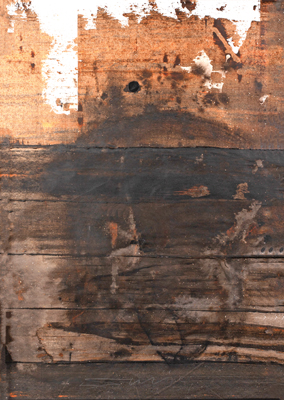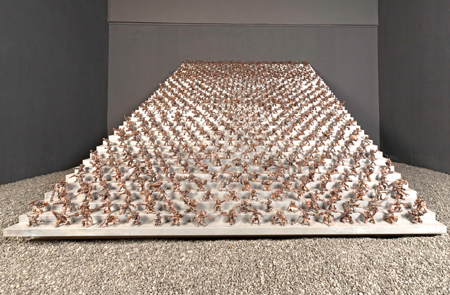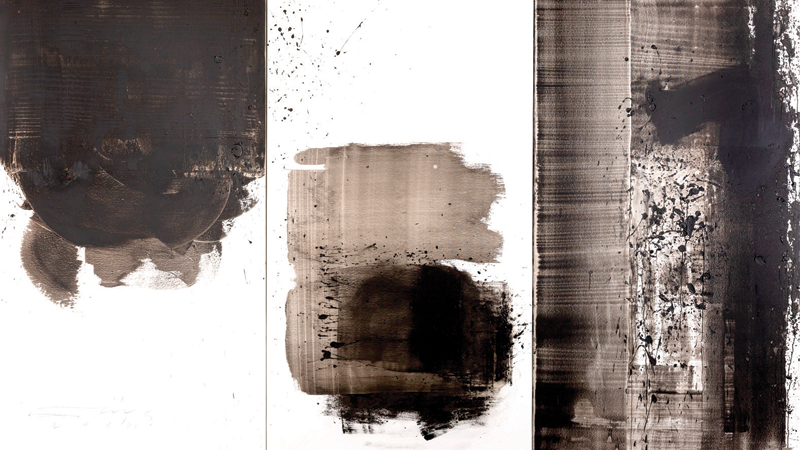 The recent exhibition ‘Maara’ by Kingsley Gunatillake is an abstract expression of the artist’s desire and enlightenment, which can be dialectical to each other, and through his artistic mastery and thoughtful colour themes, Gunatillake wins over ‘Maara’ (death).
The recent exhibition ‘Maara’ by Kingsley Gunatillake is an abstract expression of the artist’s desire and enlightenment, which can be dialectical to each other, and through his artistic mastery and thoughtful colour themes, Gunatillake wins over ‘Maara’ (death).
In reviewing the concept note for ‘Maara,’ it remains open to different meanings and weaves a story according to the viewers’ imagination. In a conversation with Kingsley Gunatillake, he interpreted ‘Maara’ as a character and the artistic drive or force within him that inspires his art. In other words, he interprets ‘Maara’ as his desire.
 Keeping this in mind, as I walked through his exhibition, a contrasting Buddhist philosophy came to my mind that often describes ‘Maara’ as the demon one must defeat to achieve Enlightenment. This implies that the fight is with our own inner desire, and one who defeats ‘Maara’ is one who achieves Enlightenment.
Keeping this in mind, as I walked through his exhibition, a contrasting Buddhist philosophy came to my mind that often describes ‘Maara’ as the demon one must defeat to achieve Enlightenment. This implies that the fight is with our own inner desire, and one who defeats ‘Maara’ is one who achieves Enlightenment.
In this context, Gunatillake is creating a new interpretation of ‘Maara’ by reimagining it as one’s creative self, ‘the desire’ that should not defeat but rather be won over to unleash our utmost inner creativity, which I find incredibly interesting. In other words, it’s a dialectical reading of the concept of ‘Maara.’ With this fascinating realisation, I sat down with Gunatillake, curious to dive deep into his creative process for ‘Maara.’
Inception of ‘Maara’
Speaking about the inception of the concept of ‘Maara,’ Gunatilleka wasn’t exactly sure when or how he began creating this idea in his mind. “I’m not exactly sure when my fascination with the concept of Maara began, but I started delving deeply into it around 2012,” Gunatilleka said.
He was intrigued by how humanity created the ideas of God and spirituality, only to then seek grace from these very concepts. His curiosity was driven by a desire to understand craving, hunger, desire, and detachment – the concepts central to both Buddhist teachings and the human experience. Although his exploration began with Buddhism, he quickly realised that there was more to it.
As he dived further, he began to notice that behind every craving and hunger lay desire, and beneath every attachment, there was an underlying force driving it. That is our innate need for fulfillment. “The more I thought about it, the more I saw how deeply our existence is tied to emotions and feelings of craving and desire,” Gunatilleka said.
He recognised that humans are driven by achievement and comfort, which, in itself, is a form of craving. “And it is ‘Maara’, in this sense, that drives this cycle,” he added.
 Gunatilleka said that he never intended to challenge traditional Buddhist teachings; his goal was simply to understand and peer beyond the surface. The more he explored, the more he realised that, like the concepts of God and spirituality, the idea of ‘Maara’ too is a human creation.
Gunatilleka said that he never intended to challenge traditional Buddhist teachings; his goal was simply to understand and peer beyond the surface. The more he explored, the more he realised that, like the concepts of God and spirituality, the idea of ‘Maara’ too is a human creation.
“Our very existence, it seems, is fuelled by desire, and our hopes are constantly motivated by cravings,” he said. For him, ‘Maara’ represents this dynamic, our relentless pursuit of desires and attachments that drive our actions.
In his view, while Buddhist teachings often depict ‘Maara’ as an illusion that blinds humanity, Gunatilleka began to see ‘Maara’ not as an illusion, but as the very fabric of our everyday reality. “It motivates our behaviour and shapes how we experience the world,” he said.
Unique colour theme
The colour palette of ‘Maara’ is unique, featuring predominantly black, white, red, and copper brown. These colours evoke a deep sense of mystery, darkness, rage, lust, peace, and harmony, capturing the complexities of human emotions. Each painting represents abstract forms, comprising layers upon layers of brush strokes that are signature to Gunatilleka’s artistic journey.
As Gunatilleka explains his artistic decisions behind selection of the colour palette and his creative process, he said, “Maara paintings were created through the process of building up layers over several days and months. Each layer was applied with flowing movements and bold strokes.”
Gunatilleka said that the paintings represent “the idea of searching for light within darkness.” While there isn’t a single clear image, the concept of ‘Maara’ emerges through the layers, each contributing to its overall presence and establishing the norms of abstract painting.
On the surface, the paintings may appear to feature aggressive strokes or dark patches, which connect to the installation. Gunatilleka said that “the focus here is on the expression rather than complex techniques or a dark composition.” The idea of revealing and hiding is central to this expression, enhancing the painting’s impact.
Stairs of miniature sculptures

Kingsley
Gunatilleka
Besides the abstract collection of paintings, the ‘Maara’ exhibition featured hundreds of miniature metal creature sculptures arranged on stairs. These creatures are abstract; although they possess some recognisable human elements, they resemble abstract gladiators holding guns and various types of weapons. Who are these creatures? In response, Gunatilleka said, “The exhibition featured 1,001 miniature copper sculptures, each no taller than 10 cm. These abstract sculptures are designed to convey a sense of life, depicting the movement of descending stairs towards the viewer.”
This installation was placed in a secluded corner of the gallery, enhancing its mysterious atmosphere. Viewers must navigate a path over small black chip rocks layered on the ground to enter this dimly lit space. Gunatilleka said that the intention was to evoke the ambiance of a Japanese shrine, creating a tranquil, almost otherworldly vibe within the gallery.
“These small Maara figurines, proportionate in size to the human body, feature faces with unusually large eyes and a smile that stretches across their entire face. The outstretched hands of each figure adopt a posture as though preparing to embrace the viewer, conveying a sense of readiness to engage and evoking the feeling of returning to familiar actions and encounters. The figures combine robotic forms with elements inspired by traditional “Sanni Yakku” (demon) masks, drawing from diverse cultural influences. The most prominent influence is the posture and shape of Japanese samurais, which is reflected in the sculptures,” he added.
When asked about his next artistic mission, Gunatilleka reflected on the past three years, saying, “I haven’t been able to get any significant rest; I’ve been working non-stop.” He decided it was time for a physical and mental break, with plans to visit galleries and museums in Tokyo. “Discussions are scheduled with some artists and art fans in Tokyo,” he said. Gunatilleka added that his next endeavour will involve thinking beyond the concept of Mara, saying, “Work is scheduled to begin at the Tokyo studio in the coming months.”
Why do you do what you do?
It’s crucial for artists to take a moment to think about what they do. Without a bit of self-criticism and reflection, how can anyone really understand their art? After all, creating isn’t just about putting brushes to canvas; it’s also about figuring out who you are in the process. As Sartre said, our choices define us, and this holds true for artists, whose creations reflect their inner selves. So, an artist’s journey involves not just making art but also having those playful conversations with themselves about what it all means.
This introspection can lead to richer, more relatable creations that truly resonate with others. To wrap up this fascinating conversation with Gunatilleka, the question arose: “Why do you do what you do?” He responded with a spark of urgency, saying, “If I don’t work, I’ll become very ill. I imagine that not working will lead to an early death. My only hope in life is to constantly engage in artistic work – it’s my lifeblood.”
With a grin, he said, “For artists, leisure isn’t lounging around; it’s all about diving headfirst into art and soaking up every moment.” He added, “It’s obvious to me that all my work is interconnected. I see my hope and intention as facing challenges head-on and overcoming them successfully.”
In essence, for Gunatilleka, life is an ongoing artistic adventure, one that fuels his spirit and keeps him vibrant.




